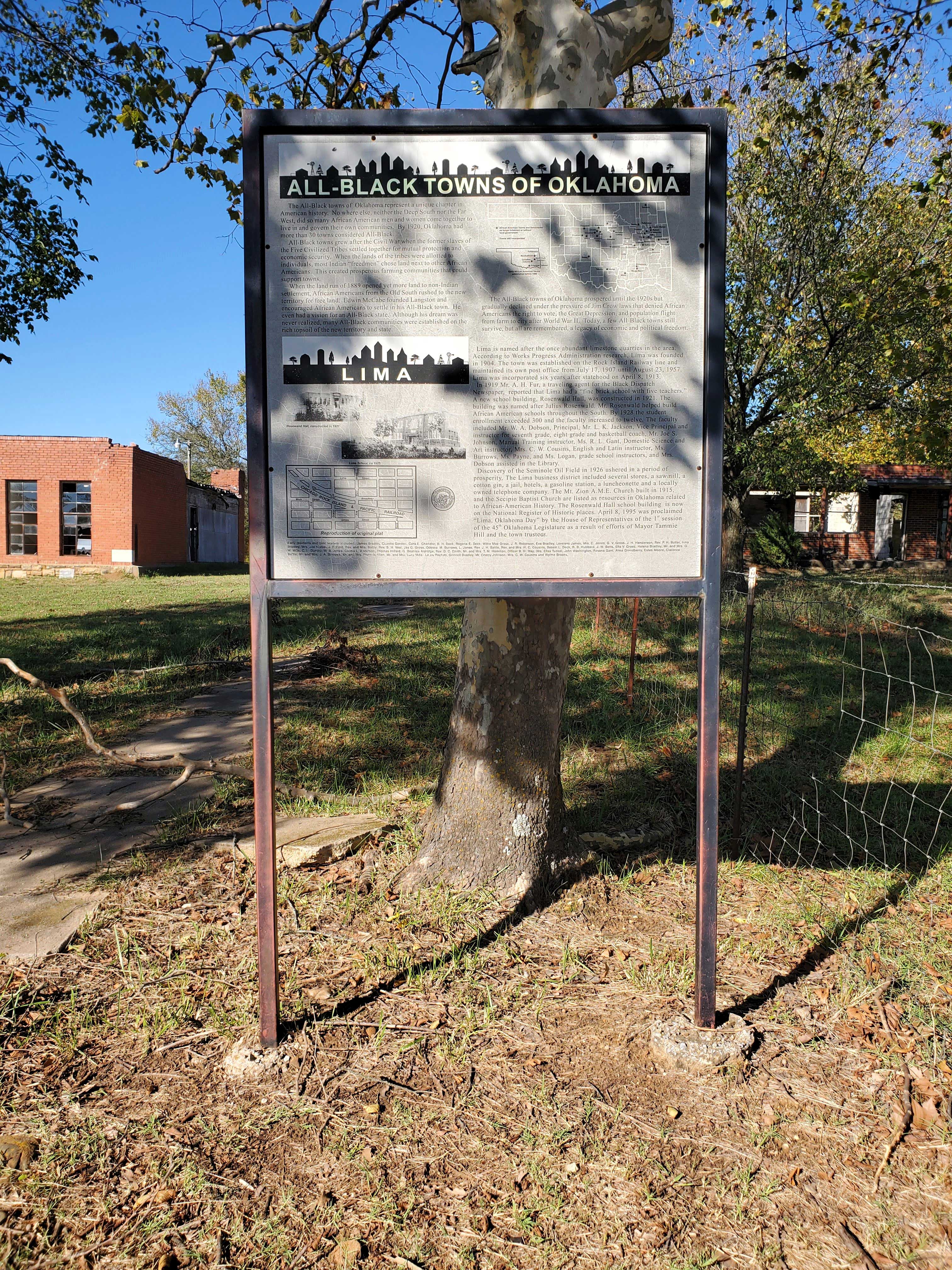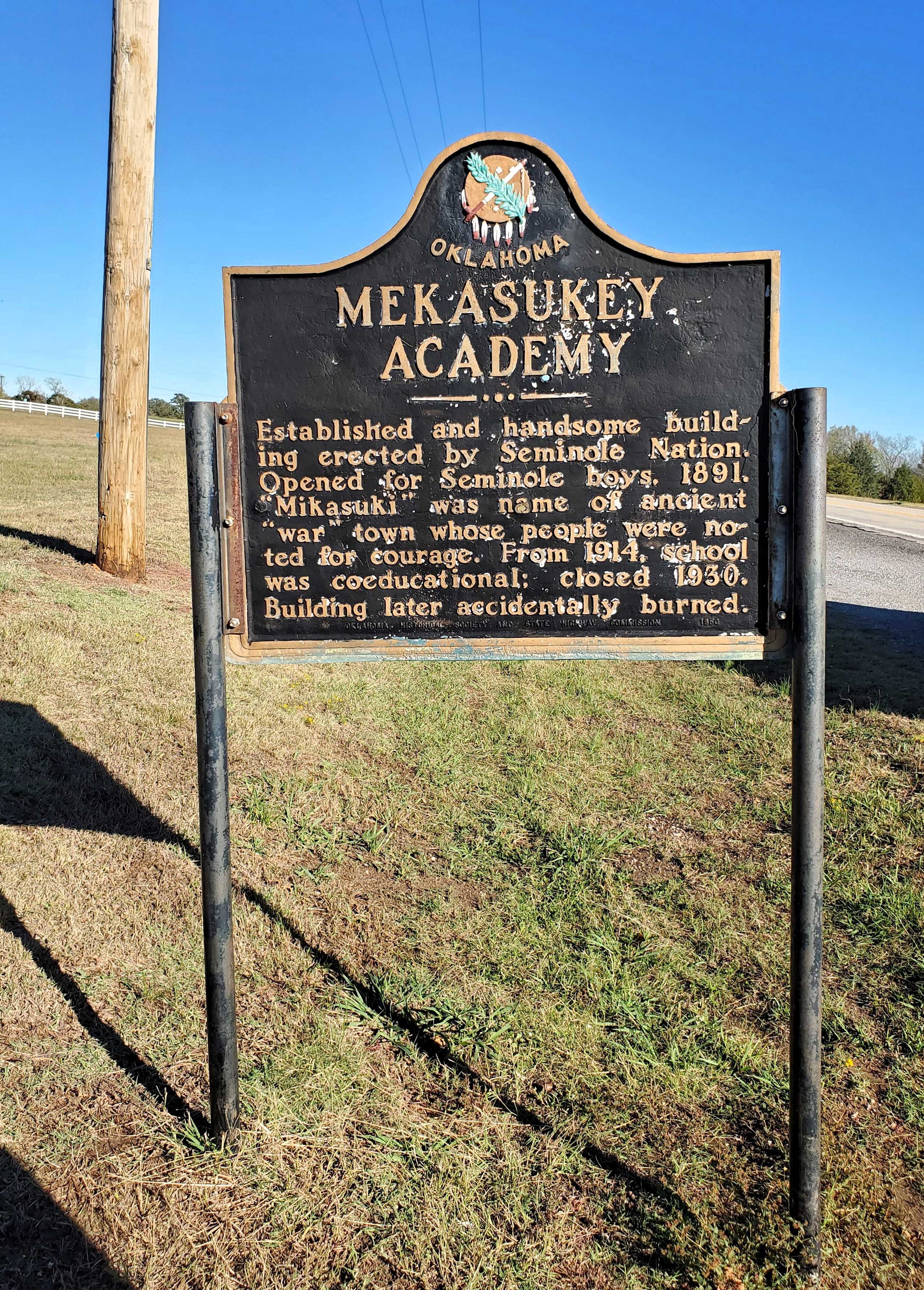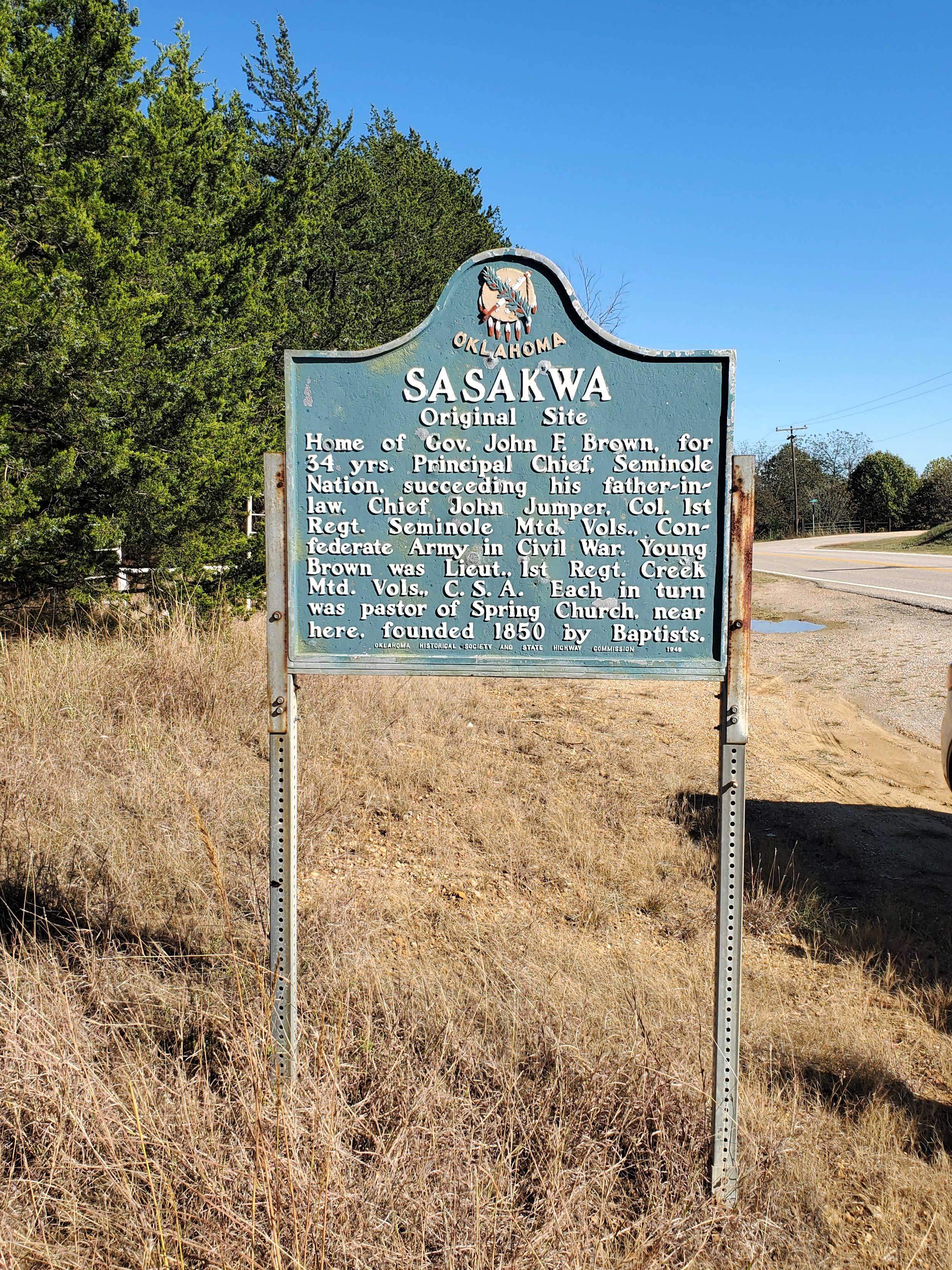
Home | About | Historical Marker Program
Location: south of the intersection of Shawnee Avenue (OK-56) and Jenkins Street in Cromwell
Coordinates: 35.340333, -96.458900
Material: Granite
Sponsor(s): Cromwell Alumni Association and the Oklahoma Historical Society
Topics: Early Statehood, 1907–1941; Folklore/Folklife; Industry/Business; Law and Order; Petroleum; Urban Development
The Cromwell oil field and town were named for Joe I. Cromwell of Muskogee, Oklahoma. A gas well, the #1 Jim Willis, was completed by the Cosden Oil Co. on November 11, 1922. However, it was not until the discovery of oil by the Cromwell Oil & Gas Company at the #1 Bruner on October 2, 1923, that the drilling boom started. A total of 393 wells produced oil in the field. The town of Cromwell and the surrounding oil field had a peak population of 10,000 during 1923 and 1924. Lawlessness became rampant and caused the town to be named “Cromwell the Wicked.” To help curb the lawlessness in the town, William (Bill) Tilghman, a pioneer law officer and one of the famous “Three Guardsmen” of Oklahoma was named chief of police in September 1924. On November 1, 1924, at the age of 70, Tilghman was slain at the entrance of Murphy’s dance hall, located where this marker stands.
Location: five miles south of Wewoka at intersection of US-270 and OK-56
Coordinates: 35.071978, -96.494292
Material: Aluminum
Sponsor(s): Oklahoma Historical Society and the Oklahoma Department of Transportation
Topics: American Indians; Early Statehood, 1907–1941; Education; Territorial Period, 1861–1907
This school for Seminole girls was established in 1894 and operated by the Seminole Nation. Reverend W. P. Blake was the first superintendent. Mrs. Alice Brown Davis, who later became first female chief of the Seminole Nation, was superintendent in 1908. The school was abandoned in 1914, and the building was destroyed by fire in 1927.
Note: This marker could not be located and is presumed missing.
Location: on the grounds of Rosenwald Hall in Lima
Coordinates: 35.173979, -96.598470
Material: Other (Interpretive Panel)
Sponsor(s): Oklahoma Historical Society
Topics: Early Statehood, 1907–1941; Education; Ethnic Diversity; Settlement Patterns; Territorial Period, 1861–1907; Urban Development
Lima is one of 13 All-Black towns, out of more than 50 that once existed, remaining in Oklahoma. While Tullahassee is reportedly the oldest, most were established between 1889 and 1907 as African Americans sought security and control of their own destiny in a segregated world. Most of the towns began to decline in the 1920s and 1930s as rural African Americans faced economic hardships and began to move to urban areas. Named for the once abundant limestone quarries in the area, Lima was founded in 1904 and maintained a post office. It is the site of Rosenwald Hall, which was constructed in 1921 with funding from Julius Rosenwald, president of Sears, Roebuck and Company and trustee of the Tuskegee Institute.
Location: on OK-59 near junction with NS 3540 Rd, approximately four miles southwest of Seminole
Coordinates: 35.188407, -96.707079
Material: Aluminum
Sponsor(s): Oklahoma Historical Society and the Oklahoma Department of Transportation
Topics: American Indians; Early Statehood, 1907–1941; Education; Territorial Period, 1861–1907
Established by the Seminole Nation, Mekasukey Academy opened in 1891 to educate Seminole boys. Mekasukey (“Mikasuki”) was named for one of the “war towns” of the Seminole Nation. The school became coeducational by 1914. Mekasukey Academy closed in 1930, and the building later burned down.

Location: on OK-56, two miles west of Sasakwa
Coordinates: 34.949236, -96.565361
Material: Aluminum
Sponsor(s): Oklahoma Historical Society and the Oklahoma Department of Transportation
Topics: American Indians; Government; Religion/Philosophy; Westward Expansion, 1803–1861
Home of Governor John F. Brown, who was principal Chief of the Seminole Nation for 34 years, succeeding his father-in-law Chief John Jumper. Jumper served as a colonel in the Seminole Mounted Volunteers for the Confederate Army during the Civil War. Brown served as a lieutenant under Chief Jumper. Each in turn was pastor of Spring Baptist Church, which was founded near this marker’s location in 1850 by Baptists.

(Page 1 of 1)
Historical Marker Program
Search Results
Your search returned 5 results.
Cromwell
Seminole CountyLocation: south of the intersection of Shawnee Avenue (OK-56) and Jenkins Street in Cromwell
Coordinates: 35.340333, -96.458900
Material: Granite
Sponsor(s): Cromwell Alumni Association and the Oklahoma Historical Society
Topics: Early Statehood, 1907–1941; Folklore/Folklife; Industry/Business; Law and Order; Petroleum; Urban Development
The Cromwell oil field and town were named for Joe I. Cromwell of Muskogee, Oklahoma. A gas well, the #1 Jim Willis, was completed by the Cosden Oil Co. on November 11, 1922. However, it was not until the discovery of oil by the Cromwell Oil & Gas Company at the #1 Bruner on October 2, 1923, that the drilling boom started. A total of 393 wells produced oil in the field. The town of Cromwell and the surrounding oil field had a peak population of 10,000 during 1923 and 1924. Lawlessness became rampant and caused the town to be named “Cromwell the Wicked.” To help curb the lawlessness in the town, William (Bill) Tilghman, a pioneer law officer and one of the famous “Three Guardsmen” of Oklahoma was named chief of police in September 1924. On November 1, 1924, at the age of 70, Tilghman was slain at the entrance of Murphy’s dance hall, located where this marker stands.
Emahaka Mission
Seminole CountyLocation: five miles south of Wewoka at intersection of US-270 and OK-56
Coordinates: 35.071978, -96.494292
Material: Aluminum
Sponsor(s): Oklahoma Historical Society and the Oklahoma Department of Transportation
Topics: American Indians; Early Statehood, 1907–1941; Education; Territorial Period, 1861–1907
This school for Seminole girls was established in 1894 and operated by the Seminole Nation. Reverend W. P. Blake was the first superintendent. Mrs. Alice Brown Davis, who later became first female chief of the Seminole Nation, was superintendent in 1908. The school was abandoned in 1914, and the building was destroyed by fire in 1927.
Note: This marker could not be located and is presumed missing.

Lima
Seminole CountyLocation: on the grounds of Rosenwald Hall in Lima
Coordinates: 35.173979, -96.598470
Material: Other (Interpretive Panel)
Sponsor(s): Oklahoma Historical Society
Topics: Early Statehood, 1907–1941; Education; Ethnic Diversity; Settlement Patterns; Territorial Period, 1861–1907; Urban Development
Lima is one of 13 All-Black towns, out of more than 50 that once existed, remaining in Oklahoma. While Tullahassee is reportedly the oldest, most were established between 1889 and 1907 as African Americans sought security and control of their own destiny in a segregated world. Most of the towns began to decline in the 1920s and 1930s as rural African Americans faced economic hardships and began to move to urban areas. Named for the once abundant limestone quarries in the area, Lima was founded in 1904 and maintained a post office. It is the site of Rosenwald Hall, which was constructed in 1921 with funding from Julius Rosenwald, president of Sears, Roebuck and Company and trustee of the Tuskegee Institute.

Mekasukey Academy
Seminole CountyLocation: on OK-59 near junction with NS 3540 Rd, approximately four miles southwest of Seminole
Coordinates: 35.188407, -96.707079
Material: Aluminum
Sponsor(s): Oklahoma Historical Society and the Oklahoma Department of Transportation
Topics: American Indians; Early Statehood, 1907–1941; Education; Territorial Period, 1861–1907
Established by the Seminole Nation, Mekasukey Academy opened in 1891 to educate Seminole boys. Mekasukey (“Mikasuki”) was named for one of the “war towns” of the Seminole Nation. The school became coeducational by 1914. Mekasukey Academy closed in 1930, and the building later burned down.


Sasakwa
Seminole CountyLocation: on OK-56, two miles west of Sasakwa
Coordinates: 34.949236, -96.565361
Material: Aluminum
Sponsor(s): Oklahoma Historical Society and the Oklahoma Department of Transportation
Topics: American Indians; Government; Religion/Philosophy; Westward Expansion, 1803–1861
Home of Governor John F. Brown, who was principal Chief of the Seminole Nation for 34 years, succeeding his father-in-law Chief John Jumper. Jumper served as a colonel in the Seminole Mounted Volunteers for the Confederate Army during the Civil War. Brown served as a lieutenant under Chief Jumper. Each in turn was pastor of Spring Baptist Church, which was founded near this marker’s location in 1850 by Baptists.


(Page 1 of 1)
Marker Search
Browse by County
Adair County
Alfalfa County
Atoka County
Beaver County
Beckham County
Blaine County
Bryan County
Caddo County
Canadian County
Carter County
Cherokee County
Choctaw County
Cimarron County
Cleveland County
Comanche County
Cotton County
Craig County
Creek County
Custer County
Delaware County
Dewey County
Ellis County
Garfield County
Garvin County
Grady County
Grant County
Greer County
Harmon County
Harper County
Haskell County
Hughes County
Jackson County
Jefferson County
Johnston County
Kay County
Kingfisher County
Kiowa County
Latimer County
Le Flore County
Lincoln County
Logan County
Love County
Major County
Marshall County
Mayes County
McClain County
McCurtain County
McIntosh County
Murray County
Muskogee County
Noble County
Okfuskee County
Oklahoma County
Okmulgee County
Osage County
Ottawa County
Pawnee County
Payne County
Pittsburg County
Pontotoc County
Pottawatomie County
Pushmataha County
Roger Mills County
Rogers County
Seminole County
Sequoyah County
Stephens County
Texas County
Tillman County
Tulsa County
Wagoner County
Washington County
Washita County
Woods County
Woodward County
Alfalfa County
Atoka County
Beaver County
Beckham County
Blaine County
Bryan County
Caddo County
Canadian County
Carter County
Cherokee County
Choctaw County
Cimarron County
Cleveland County
Comanche County
Cotton County
Craig County
Creek County
Custer County
Delaware County
Dewey County
Ellis County
Garfield County
Garvin County
Grady County
Grant County
Greer County
Harmon County
Harper County
Haskell County
Hughes County
Jackson County
Jefferson County
Johnston County
Kay County
Kingfisher County
Kiowa County
Latimer County
Le Flore County
Lincoln County
Logan County
Love County
Major County
Marshall County
Mayes County
McClain County
McCurtain County
McIntosh County
Murray County
Muskogee County
Noble County
Okfuskee County
Oklahoma County
Okmulgee County
Osage County
Ottawa County
Pawnee County
Payne County
Pittsburg County
Pontotoc County
Pottawatomie County
Pushmataha County
Roger Mills County
Rogers County
Seminole County
Sequoyah County
Stephens County
Texas County
Tillman County
Tulsa County
Wagoner County
Washington County
Washita County
Woods County
Woodward County
Contact Us
If you have questions, please contact:
Matthew Pearce
Oklahoma Historical Society
800 Nazih Zuhdi Drive
Oklahoma City, OK 73105
405-522-8659
matthew.pearce@history.ok.gov





